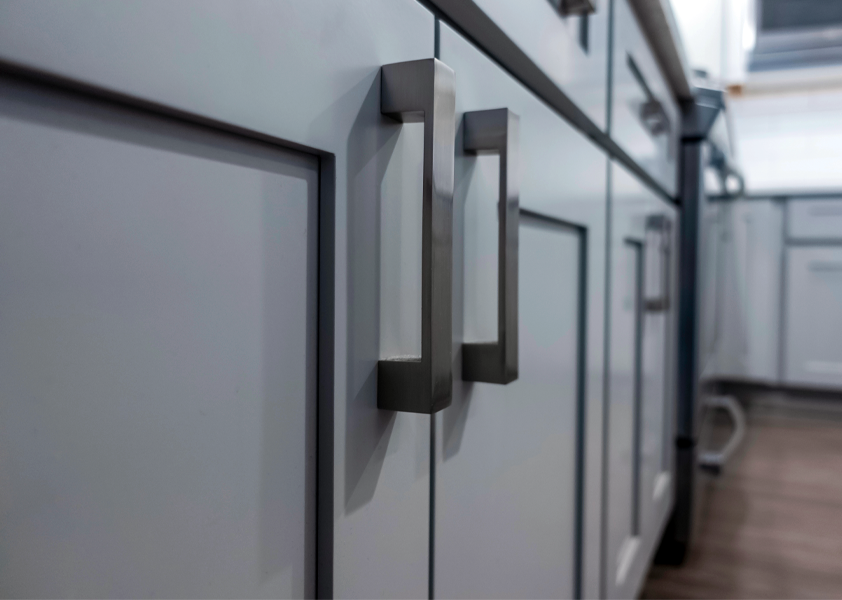When designing a luxury kitchen, cabinetry is one of the most important elements to consider. It not only defines the space’s style and functionality but also significantly impacts durability and performance due to its construction and materials. This guide will outline the various types of kitchen cabinetry, differences in construction, framed versus frameless options, material choices, cost factors, and different overlay styles. Our goal is to help you make an informed decision about your dream kitchen.
Types of Kitchen Cabinet Construction
Kitchen cabinets are typically categorized into three construction types: stock, semi-custom, and custom.
Stock Cabinets – These are pre-manufactured cabinets available in standard sizes and limited styles. They are the most budget-friendly option but offer the least customization.
Semi-Custom Cabinets – These provide more flexibility in design, finishes, and storage options while maintaining a more accessible price point than fully custom cabinets.
Custom Cabinets – Built to precise specifications, custom cabinetry offers unlimited design possibilities, premium materials, and superior craftsmanship, making it ideal for high-end kitchen designs. Custom options come at a higher cost but offer unparalleled quality and personalization.
Framed vs. Frameless Cabinets
The choice between framed and frameless cabinetry affects both aesthetics and functionality. Knowing the difference is crucial to selecting whats right for you.
Framed Cabinets – These have a face frame attached to the front of the cabinet box, adding strength and structure. The doors are mounted to the frame, which can accommodate different overlay styles (discussed below). This traditional construction is commonly used in American-style kitchens and is available in a range of price points depending on materials and customization.
Frameless Cabinets – Also known as full-access and European-style cabinetry, frameless cabinets do not have a face frame, allowing for a sleek, modern look with full access to the interior. The absence of a frame provides more storage space and a seamless aesthetic but often comes at a premium due to precision manufacturing and installation.
Material Differences in Cabinetry
Cabinet material impacts longevity, appearance, and overall quality.
Here are some common options:
Solid Wood – A premium choice for luxury kitchens, solid wood cabinets are durable and offer natural beauty. Different wood species vary in cost, with exotic hardwoods being more expensive.
Plywood – Considered a high-quality option, plywood cabinets are strong, resistant to moisture, and provide excellent structural integrity. They are generally more expensive than MDF or particleboard but offer better durability.
Medium-Density Fiberboard (MDF) – A cost-effective and smooth alternative to solid wood, MDF is ideal for painted finishes but may not be as durable as plywood. It falls in the mid-range pricing category.
Particleboard – The most budget-friendly option, particleboard is lightweight but less durable and more susceptible to water damage. It is typically found in lower-end cabinetry.
Metal & Glass – Contemporary kitchens often incorporate metal or glass cabinetry for a sleek, industrial look. These materials add a unique aesthetic but are often among the most expensive options.
Acrylic – A high-gloss, ultra-modern material that provides a sleek, reflective finish. Acrylic cabinets are durable, scratch-resistant, and easy to clean, making them a popular choice for contemporary kitchens. They are generally priced in the mid-to-high range depending on quality.
Matte Foils – A cost-effective alternative to painted finishes, matte foils provide a soft, smooth appearance without the high maintenance of traditional paint. They are available in various colors and textures, offering a stylish option.
Did You Know:
Most cabinetry lines offer material upgrades to wood or plywood boxes. We recommend this for added durability.
Overlay Types for Cabinet Doors
Cabinet Overlay refers to how the cabinet doors fit over the frame or box, impacting the overall look and style of your kitchen.
Full Overlay – The doors and drawers cover almost the entire cabinet frame, creating a seamless, modern appearance. This style is commonly found in mid-to-high-end cabinetry due to its precise construction.
Partial Overlay – A more traditional style where some of the frame remains visible between doors and drawers. It is generally more budget-friendly than full overlay.
Inset – Doors and drawers are set within the cabinet frame rather than overlapping it, offering a classic and sophisticated appearance with precise craftsmanship. Inset cabinets are typically the most expensive due to the precision required in their construction.
Choosing the Right Cabinets for Your Luxury Kitchen Build or Renovation
When selecting cabinetry for your high-end kitchen, consider your style preferences, storage needs, and long-term durability. Custom cabinetry allows for unparalleled personalization, while premium materials like solid wood and plywood ensure longevity. Whether you prefer the classic elegance of inset framed cabinets or the sleek modernity of frameless full overlay, choosing the right cabinetry will set the foundation for a stunning and functional kitchen.
Need expert guidance? Pryde Designs specializes in luxury kitchen cabinetry and custom millwork, helping homeowners create exquisite, tailor-made kitchens that blend beauty and functionality effortlessly. Contact us today to begin designing your dream kitchen!
